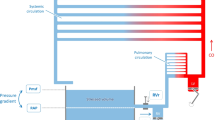Abstract
Recent studies challenge the utility of central venous pressure monitoring as a surrogate for cardiac preload. Starting with Starling’s original studies on the regulation of cardiac output, this review traces the history of the experiments that elucidated the role of central venous pressure in circulatory physiology. Central venous pressure is an important physiologic parameter, but it is not an independent variable that determines cardiac output.






Similar content being viewed by others
Abbreviations
- CVP:
-
Central venous pressure
References
Patterson SW, Starling EH. On the mechanical factors which determine the output of the ventricles. J Physiol. 1914;48:357–79.
Dellinger RP, Levy MM, Rhodes A, Annane D, Gerlach H, Opal SM. Surviving Sepsis Campaign: international guidelines for management of severe sepsis and septic shock, 2012. Intensive Care Med. 2013;39:165–228.
Funk DJ, Kumar A. If the central venous pressure is [x], call me … maybe. Crit Care Med. 2013;41:1823–4.
Shippy CR, Appel PL, Shoemaker WC. Reliability of clinical monitoring to assess blood volume in critically ill patients. Crit Care Med. 1984;12:107–12.
Marik PE, Baram M, Vahid B. Does central venous pressure predict fluid responsiveness? A systematic review of the literature and the tale of seven mares. CHEST J. 2008;134:172–8.
Marik PE, Cavallazzi R. Does the central venous pressure predict fluid responsiveness? An updated meta-analysis and a plea for some common sense. Crit Care Med. 2013;41:1774–81.
Durairaj L, Schmidt GA. Fluid therapy in resuscitated sepsis: less is more. Chest. 2008;133:252–63.
Henderson J. A Life of Ernest Starling. New York: published for the American Physiological Society by Oxford University Press; 2005.
Guyton AC, Jones CE, Coleman TG. Circulatory Physiology: Cardiac Output and its Regulation. 2nd ed. Philadelphia, PA: Saunders; 1973.
Starling EH. The Linacre Lecture on the Law of the Heart. London: Longmans, Green, & Company; 1918.
Daly IDB. The Second Bayliss–Starling Memorial Lecture. Some aspects of their separate and combined research interests. J Physiol. 1967;191:1.
Sarnoff SJ, Berglund E. Ventricular function: I. Starling's Law of the Heart studied by means of simultaneous right and left ventricular function curves in the dog. Circulation. 1954;9:706–18.
Isaacs JP, Berglund E, Sarnoff SJ. Ventricular function: III. The pathologic physiology of acute cardiac tamponade studied by means of ventricular function curves. Am Heart J. 1954;48:66–76.
Sarnoff SJ. Myocardial contractility as described by ventricular function curves; observations on Starling's Law of the Heart. Physiol Rev. 1955;35:107–22.
Braunwald E. The control of ventricular function in man. Br Heart J. 1965;27:1.
Rushmer RF. Applicability of Starling's Law of the Heart to intact, unanesthetized animals. Physiol Rev. 1955;35:138–42.
Berlin DA, Bakker J. Understanding venous return. Intensive Care Med. 2014;40:1564–6.
Berlin D. Hemodynamic consequences of auto-PEEP. J Intensive Care Med. 2014;29:81–6.
Forrester JS, Diamond G, McHugh TJ, Swan HJC. Filling pressures in the right and left sides of the heart in acute myocardial infarction. N Engl J Med. 1971;285:190–3.
Damman K, van Deursen VM, Navis G, Voors AA, van Veldhuisen DJ, Hillege HL. Increased central venous pressure is associated with impaired renal function and mortality in a broad spectrum of patients with cardiovascular disease. J Am Coll Cardiol. 2009;53:582–8.
van Deursen VM, Damman K, Hillege HL, van Beek AP, van Veldhuisen DJ, Voors AA. Abnormal liver function in relation to hemodynamic profile in heart failure patients. J Card Fail. 2010;16:84–90.
Mullens W, Abrahams Z, Francis GS, Sokos G, Taylor DO, Starling RC, et al. Importance of venous congestion for worsening of renal function in advanced decompensated heart failure. J Am Coll Cardiol. 2009;53:589–96.
Bock JS, Gottlieb SS. Cardiorenal syndrome: new perspectives. Circulation. 2010;121:2592–600.
Boyd JH, Forbes J, Nakada TA, Walley KR, Russell JA. Fluid resuscitation in septic shock: a positive fluid balance and elevated central venous pressure are associated with increased mortality. Crit Care Med. 2011;39:259–65.
Legrand M, Dupuis C, Simon C, Gayat E, Mateo J, Lukaszewicz AC, et al. Association between systemic hemodynamics and septic acute kidney injury in critically ill patients: a retrospective observational study. Crit Care. 2013;17:R278.
Vieillard-Baron A, Prin S, Chergui K, Dubourg O, Jardin F. Echo-Doppler demonstration of acute cor pulmonale at the bedside in the medical intensive care unit. Am J Respir Crit Care Med. 2002;166:1310–9.
Mebazaa A, Karpati P, Renaud E, Algotsson L. Acute right ventricular failure – from pathophysiology to new treatments. Intensive Care Med. 2004;30:185–96.
Guyton AC, Lindsey AW, Gilluly JJ. The limits of right ventricular compensation following acute increase in pulmonary circulatory resistance. Circulat Res. 1954;2:326–32.
Jardin F, Vieillard-Baron A. Ultrasonographic examination of the venae cavae. Intensive Care Med. 2006;32:203–6.
Guyton AC, Hall JE. Textbook of Medical Physiology. 11th ed. Philadelphia, PA: Elsevier Saunders; 2006.
Author information
Authors and Affiliations
Corresponding author
Additional information
Competing interests
The authors declare that they have no competing interests.
Rights and permissions
About this article
Cite this article
Berlin, D.A., Bakker, J. Starling curves and central venous pressure. Crit Care 19, 55 (2015). https://doi.org/10.1186/s13054-015-0776-1
Published:
DOI: https://doi.org/10.1186/s13054-015-0776-1




